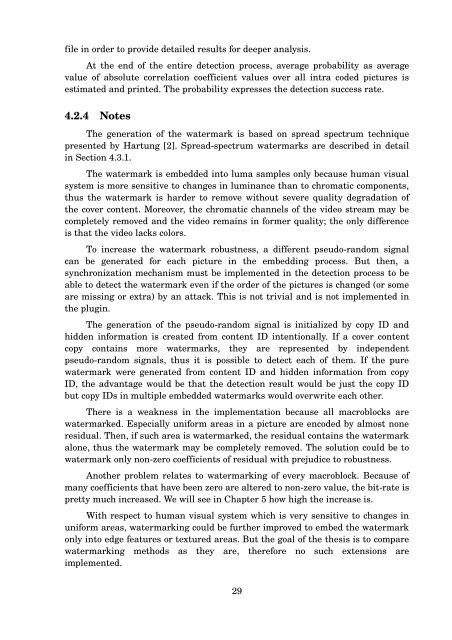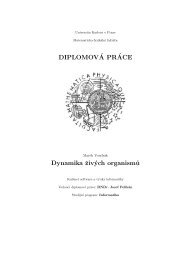MASTER THESIS Video Watermarking - Computer Graphics Group ...
MASTER THESIS Video Watermarking - Computer Graphics Group ...
MASTER THESIS Video Watermarking - Computer Graphics Group ...
You also want an ePaper? Increase the reach of your titles
YUMPU automatically turns print PDFs into web optimized ePapers that Google loves.
file in order to provide detailed results for deeper analysis.<br />
At the end of the entire detection process, average probability as average<br />
value of absolute correlation coefficient values over all intra coded pictures is<br />
estimated and printed. The probability expresses the detection success rate.<br />
4.2.4 Notes<br />
The generation of the watermark is based on spread spectrum technique<br />
presented by Hartung [2]. Spread-spectrum watermarks are described in detail<br />
in Section 4.3.1.<br />
The watermark is embedded into luma samples only because human visual<br />
system is more sensitive to changes in luminance than to chromatic components,<br />
thus the watermark is harder to remove without severe quality degradation of<br />
the cover content. Moreover, the chromatic channels of the video stream may be<br />
completely removed and the video remains in former quality; the only difference<br />
is that the video lacks colors.<br />
To increase the watermark robustness, a different pseudo-random signal<br />
can be generated for each picture in the embedding process. But then, a<br />
synchronization mechanism must be implemented in the detection process to be<br />
able to detect the watermark even if the order of the pictures is changed (or some<br />
are missing or extra) by an attack. This is not trivial and is not implemented in<br />
the plugin.<br />
The generation of the pseudo-random signal is initialized by copy ID and<br />
hidden information is created from content ID intentionally. If a cover content<br />
copy contains more watermarks, they are represented by independent<br />
pseudo-random signals, thus it is possible to detect each of them. If the pure<br />
watermark were generated from content ID and hidden information from copy<br />
ID, the advantage would be that the detection result would be just the copy ID<br />
but copy IDs in multiple embedded watermarks would overwrite each other.<br />
There is a weakness in the implementation because all macroblocks are<br />
watermarked. Especially uniform areas in a picture are encoded by almost none<br />
residual. Then, if such area is watermarked, the residual contains the watermark<br />
alone, thus the watermark may be completely removed. The solution could be to<br />
watermark only non-zero coefficients of residual with prejudice to robustness.<br />
Another problem relates to watermarking of every macroblock. Because of<br />
many coefficients that have been zero are altered to non-zero value, the bit-rate is<br />
pretty much increased. We will see in Chapter 5 how high the increase is.<br />
With respect to human visual system which is very sensitive to changes in<br />
uniform areas, watermarking could be further improved to embed the watermark<br />
only into edge features or textured areas. But the goal of the thesis is to compare<br />
watermarking methods as they are, therefore no such extensions are<br />
implemented.<br />
29
















